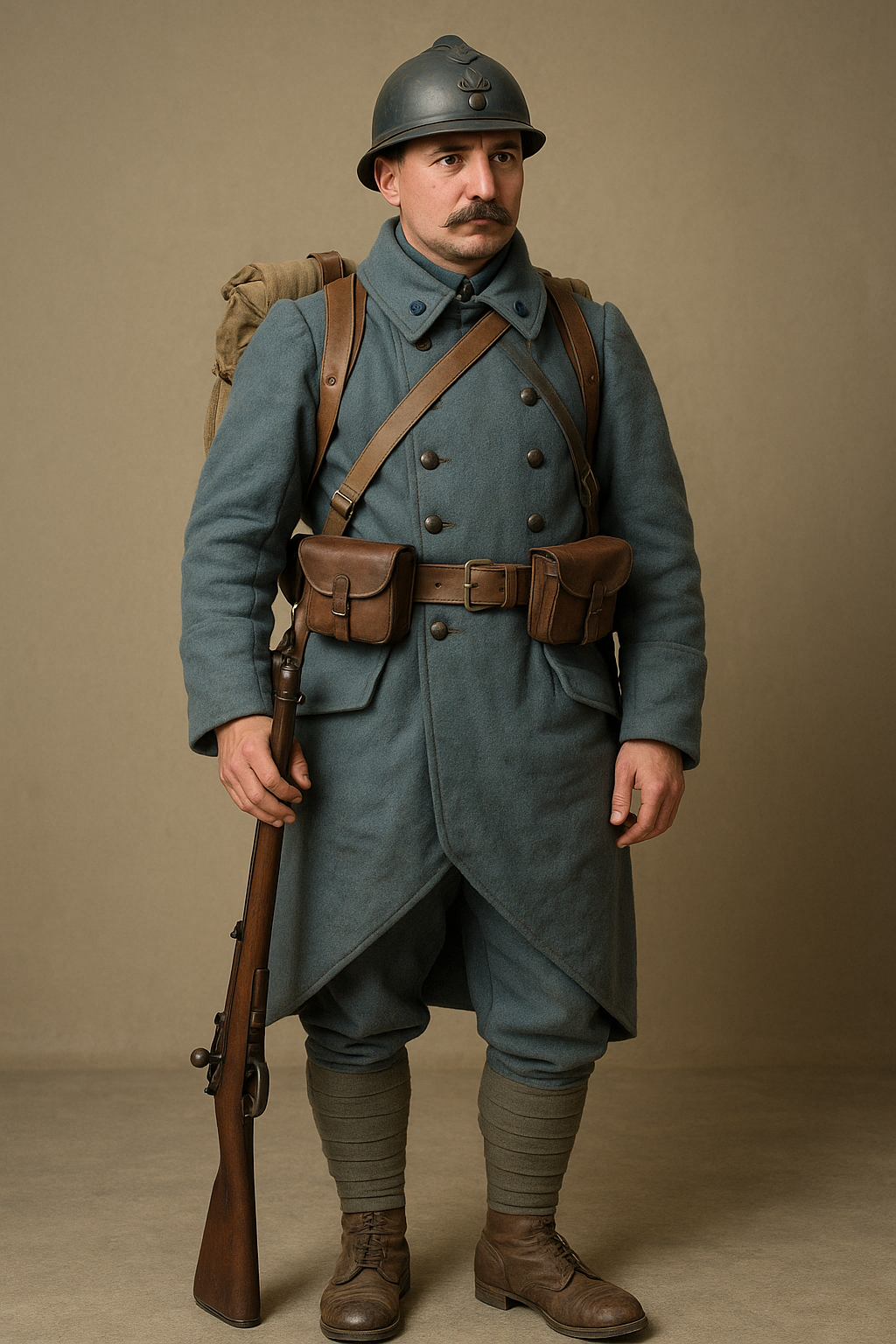
WW1 French Uniforms: A Complete Collector's Guide to Horizon Blue History
Published on Sep 22, 2025
Introduction:
Did you know that early WW1 French soldiers went to war wearing bright blue coats and red trousers?
In the age of machine guns and trench warfare, this was more than just a fashion faux pas—it was a tactical disaster.
Yet, the iconic French WW1 uniform has fascinated historians, collectors, and reenactors for decades. From its bold colors to its eventual shift toward camouflage and practicality, the evolution of French uniforms in WW1 tells a compelling story of adaptation and identity in times of crisis.
If you’re interested in collecting WW1 militaria, researching military fashion, or simply curious about why French WW1 uniforms were blue, this article is for you.
H2: The History & Evolution of the French WW1 Uniform
A Legacy of Style Meets Battlefield Reality
When World War I began in 1914, French infantry soldiers—the famous Poilus—were outfitted in the traditional uniform that hadn’t changed much since the 19th century. This included:
- Horizon blue wool tunic and trousers
- Red kepi (cap) and crimson trousers (earlier phase)
- Leather belts and ammo pouches
- Puttees or gaiters wrapped around their lower legs
- Adrian helmets (introduced in 1915)
The early uniform reflected military pride more than battlefield necessity. The vibrant colors were rooted in Napoleonic tradition, intended to boost morale and display regimental pride. But these flamboyant uniforms quickly became a liability under modern firepower.
Why Were French WW1 Uniforms Blue?
The shift to “horizon blue” in 1915 was a response to this danger. The French high command realized that red trousers made soldiers easy targets. Horizon blue—a grey-blue shade—was chosen as a compromise:
- Camouflage Effect: It blended slightly better with the European landscape.
- Dye Availability: Blue dye was more accessible than khaki due to wartime shortages.
- National Identity: The French were reluctant to adopt British-style khaki, as it might diminish their national character.
So, why blue and not brown or green? It was partially symbolic, partially practical, and partly circumstantial.
When Did the French Army Switch Uniforms in WW1?
The uniform transition began in late 1914 but wasn't fully standardized until early 1915 with the introduction of the Adrian helmet and the full switch to horizon blue.
Fun Fact: The Adrian helmet was the first modern steel helmet adopted during WW1 and was later copied by other nations.
H2: Actionable Tips for Collecting French WW1 Uniforms
Whether you're a seasoned collector or just getting started, diving into the world of 100% French WW1 uniforms is exciting—but also full of challenges. Here are expert tips to get you started:
1. Start with the Basics: Know What to Look For
Authentic WW1 French uniforms typically include:
- Horizon blue wool tunic (model 1915 or later)
- Pantalon rouge (pre-1915 uniforms)
- Adrian helmet (marked with regimental insignia)
- Mle 1892 leather belt and pouches
- Regimental markings inside the garments
Pro tip: Look for unit stamps or tailor marks inside the tunic or cap. These can confirm authenticity and origin.
2. Avoid Common Pitfalls
Many collectors make these mistakes:
❌ Buying unverified reproductions, thinking they’re real
❌ Ignoring condition and preservation issues (moth damage is common)
❌ Overpaying due to a lack of knowledge or market research
❌ Not verifying the model year (Mle 1877 vs Mle 1915, for instance)
Always buy from reputable dealers and ask for provenance—that’s the uniform’s history of ownership.
3. Verify 100% French WW1 Uniforms
If you're aiming for transactional intent and looking to buy or sell authentic gear, here’s a quick checklist:
Item Feature to Verify Collector’s Tip
Tunic Horizon blue wool, correct cut , M1915 model had shoulder epaulettes
Helmet Adrian, stamped & insignia. Early models lack chinstrap upgrades
Trousers Color & material Pre-1915 are crimson, post-1915 are blue
Boots with Hobnail soles , Reenactors prefer reproduction for wear
Belts : Leather, stamped Avoid post-war leather substitutes
4. Current Trends in WW1 French Uniform Collecting
The militaria market is constantly evolving. Here’s what’s trending in 2025:
- Digital Provenance: Blockchain-based certificates are gaining ground for verifying authenticity.
- 3D Scanning & Preservation: Museums and collectors are digitally archiving uniforms.
- Reenactment Growth: There's a rising demand for high-quality reproductions that match original specs.
- YouTube and Social Media: Collectors share finds, reviews, and DIY restoration tips.
- Rise in French Auction Sites: French-based militaria websites are booming, offering better access to local finds.
H2: Reenacting with French Uniforms — A Beginner's Guide
WW1 reenactments are immersive and educational. If you’re looking to step into the boots of a Poilu, here’s how to do it right:
Get Your Uniform Right
Start with a reproduction M1915 uniform and Adrian helmet. Don't forget:
- Leather belt and pouches
- Canvas backpack (Mle 1893)
- Mess kit, canteen, and entrenching tool
Learn the Language
Many reenactors also use basic French commands and trench slang to enhance realism. Learning terms like “En avant!” (Forward!) or “Masque!” (Gas mask!) adds authenticity.
Join a Group
Find a reenactment unit that focuses on French WW1 impressions. Being part of a group helps you access knowledge, equipment sources, and community.
Conclusion: Bring History to Life Through French WW1 Uniforms
The French WW1 uniform is more than just fabric and stitching—it’s a window into the bravery, struggles, and identity of a nation at war. Whether you're collecting for display, reenacting, or studying the nuances of wartime evolution, these uniforms offer a deep and fascinating journey.
With knowledge, patience, and the right connections, you can find authentic 100% French WW1 uniforms, avoid fakes, and become a part of a passionate community preserving history.
